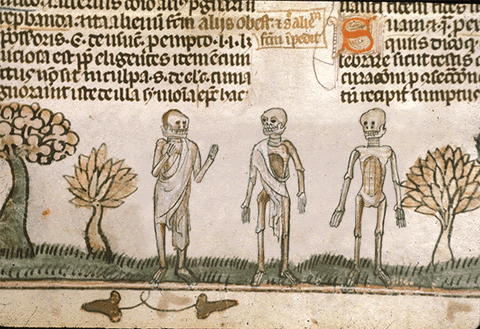
Tarantism (n.): a psychological condition characterized by an irresistible urge to dance, prevalent in Southern Italy from the 15th through the 17th century and popularly attributed to the bite of a tarantula.
In July of 1518, a woman known as Frau Troffea wordlessly stepped out of her Strasbourg home and began to dance in the blazing summer heat. There was no music, nobody accompanied her, and her face showed no trace of joy. Nobody knew why she was dancing, but she kept at it for days on end, pausing only for a few minutes at a time to eat and drink.
Frau Troffea’s bizarre behavior marked the beginning of a dancing plague that swept across the city of Strasbourg, France, compelling several hundred people—mostly young women like Frau Troffea—to dance in the streets for weeks on end for no apparent reason at all. Their feet bled, they collapsed from heat strokes and exhaustion, and some even died. Perhaps the strangest thing about it all was that none seemed to want to be dancing. They screamed, writhed in pain, begged for help, and complained of terrifying visions—but in spite of this, none were able to stop themselves from dancing. Doctors were baffled, but after ruling out the usual astrological and supernatural causes, they eventually came to the conclusion that their condition must be due to “hot blood” affecting their brains, something that seems to have happened pretty routinely in the summer months back then. But instead of giving them something to cool them down, they prescribed still more dancing, hoping to wear the dancers out. A stage was constructed, a band was brought in to play fast-paced music, “strong men” were hired to hold the exhausted dancers up so they didn’t collapse, and extra dancers were ushered into what essentially became a giant, months-long block party—only nobody was having a good time and it ended in several deaths.

The 1518 dancing plague is especially well-documented because it was written about by the famous Renaissance physician Paracelsus, but similar cases were reported in Europe as early as the 11th century. Their cause is still unknown. It’s possible that the dancers believed themselves to be cursed by St. Vitus (namesake of St. Vitus’s dance, aka Sydenham’s chorea, which involves rapid, jerking movements of the hands and feet), and that this belief spread from person to person, leading to a mass hysteria. Another theory is that the dancers accidentally ingested ergot, a toxic mold that grows on bread and, if eaten, causes spasms and hallucinations.
In Southern Italy, dancing plagues were believed to be caused by the bite of what were then called tarantulas (now they’re called wolf spiders, and they bear no relation to the modern-day tarantulas of North America), hence the word “tarantism.” There are many stories of people in Medieval Italy reporting that the bite of a tarantula caused them to fall into a deep, despondent stupor that they were unable to shake until musicians gathered around them and played a tune. This was the only cure; as soon as the tarantata (as the bitten person was called) heard a tune they liked, they would immediately perk up and dance for days on end until their tarantism was miraculously cured. This remedy is rumored to be the origin of the tarantella, an Italian folk dance. All three words—tarantism, tarantula, and tarantella—are derived from the name of their city of origin, Taranto.

Whether or not the dancing plagues of Southern Italy were actually caused by the bite of a wolf spider (which seems unlikely, considering that they aren’t actually very poisonous to humans), the fact remains that there was a bizarre period of history where people were routinely possessed by an urge to literally dance themselves to death. So far, neither historians nor scientists have been able to solve the puzzle of why this happened. Could the answer lie in art? Let’s take a look at a few paintings of people who have been possessed by dancing fevers through the ages to find out.
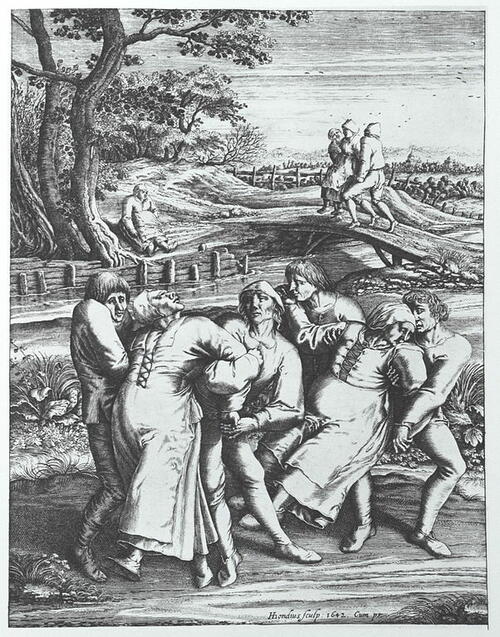 Bruegel may have actually witnessed an outbreak of the dancing plague firsthand in 1564. Shown here in an engraving he did that same year, three anguished and exhausted looking women dance while being held up by pairs of strong men so they don’t keel over from overexertion, a scene which matches descriptions of the dancing plague of 1518 exactly.
Bruegel may have actually witnessed an outbreak of the dancing plague firsthand in 1564. Shown here in an engraving he did that same year, three anguished and exhausted looking women dance while being held up by pairs of strong men so they don’t keel over from overexertion, a scene which matches descriptions of the dancing plague of 1518 exactly.
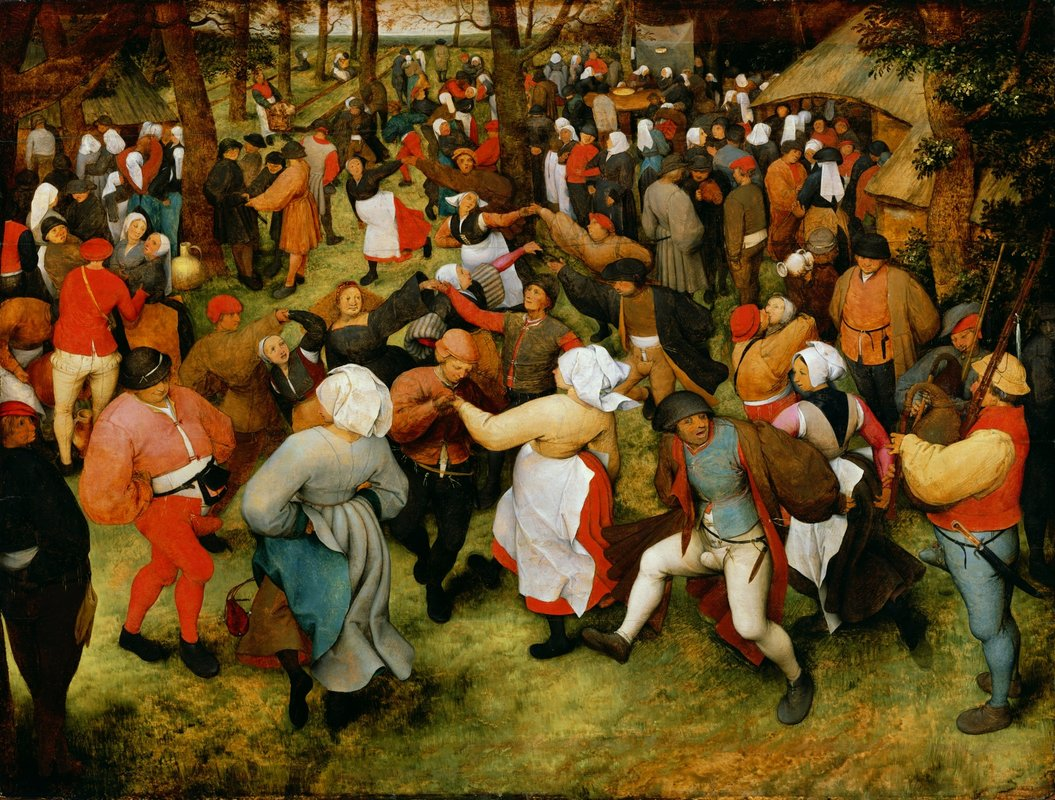
Pieter Bruegel the Elder, The Wedding Dance, in the Detroit Institute of Arts
In The Wedding Dance, thankfully, everyone looks like they’re having a much better time. There do appear to be a few folks suffering from what Medieval doctors liked to call “hot blood” though, like the couples who’ve slipped away into the woods to make out and the guy on the far left draining his jug of wine to the dregs. Breugel’s painting gives us a good idea of what people were wearing and how they were dancing at a time when dancing plagues were at their height.
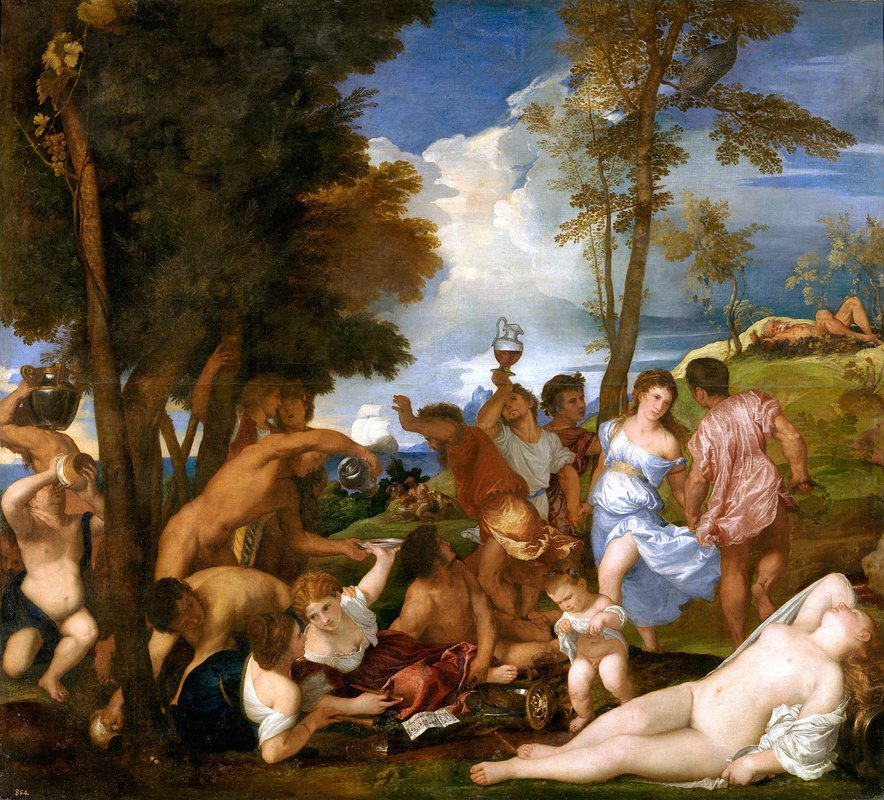
Titian, The Bacchanal of the Andrians, in the Prado National Museum
Some have speculated that these so-called dancing plagues were actually relics of Europe’s pagan past. As Christianity became established as the official religion of the Roman Empire in the 4th century, it was common practice to replace the old pagan deities with Christian saints. St. Vitus may have been a replacement for the pagan god Svetovid, who like the Roman Bacchus was a god of fertility and abundance. The people who partook in the dancing plagues may have been part of a religious cult devoted to Svetovid, which would explain the phenomenon’s obscure connection to St. Vitus.
The dancing plagues bear many similarities to Ancient Roman bacchanals, which, as you can see in Titian’s Bacchanal of the Andrians, were basically drunken orgies. The dancers were described as entering an altered state of consciousness and losing control of their actions, often to the point of making animal sounds, making obscene gestures, ripping off all their clothes, and even having outright sexual intercourse. Perhaps the dancing plague was a cover for these people to participate in pagan rituals without being persecuted.
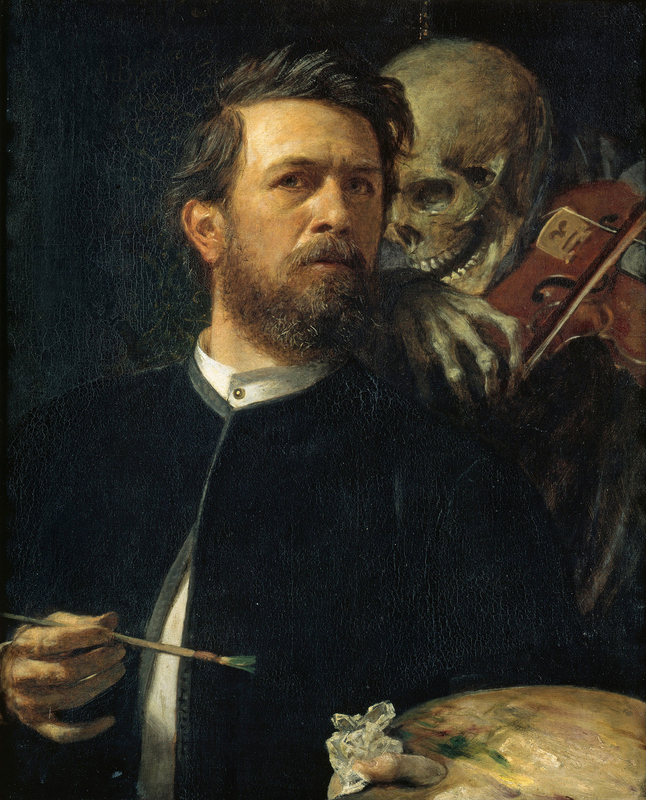
Arnold Böcklin, Self-portrait with Fiddling Death, in the Old National Gallery.
Arnold Böcklin’s creepy self-portrait brings to mind another dance of the Late Middle Ages: the danse macabre (or “dance of death”), an artistic allegory in which skeletons dance together and play musical instruments, famously portrayed by Hans Holbein the Younger in a series of woodcuts. The message of the danse macabre was that death is universal; all of us must die, no matter what our station in life. The motif grew popular in the wake of the Black Death in the 14th century, serving as a comfort to those who had lost loved ones to the epidemic.
Some have postulated that the dancing plague of 1518 was, like the danse macabre in art, a way of dealing with stressful events. The year 1518 brought outbreaks of smallpox, syphilis, and leprosy, as well as a famine caused by cold winters, hot summers, crop frosts, and hailstorms. And why shouldn’t they have just danced their troubles away? It seems as healthy a way to cope with stress as any.
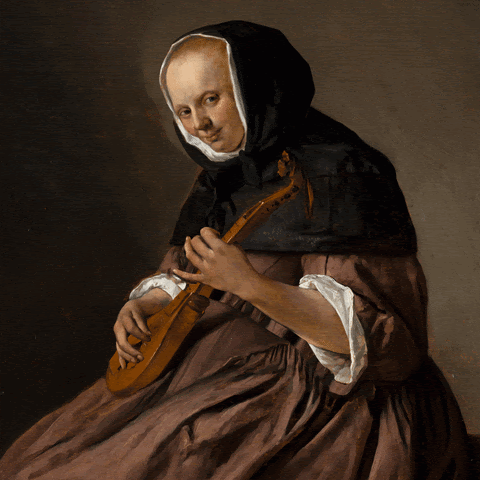
And that concludes our brief delve into the strange and wonderful history of tarantism. The real cause of it may always be a mystery, but one thing we can know for sure is that people in the Medieval period sure knew how to party hard (maybe a little too hard, but the point stands nonetheless).
Sources
- Calabrese, Angelica. “The Tarantula-Possessed Women Who Could Only Be Cured By Dance.” Atlas Obscura, October 26, 2015. https://www.atlasobscura.com/articles/the-tarantula- possessed-women-who-could-only-be-cured-by-dance.
- Goran, David. “‘Dancing Plague’ of 1518—People danced for days without rest, some even to their deaths.” The Vintage News, December 18, 2015. https://www.thevintagenews.com /2015/12/18/41515/.
- Turner, Osie. “The Dance Manias of the Dark Ages.” Osie Turner (blog), October 21, 2012. https://www.osieturner.com/2012/10/the-dance-manias-of-dark-ages.html.
- Waller, John. “A forgotten plague: making sense of dancing mania.” The Lancet 373, no. 9664 (2009): 624-625. Accessed December 8, 2020. https://www.thelancet.com/journals/ lancet/article/PIIS014067360960386X/fulltext.
- —. “Keep on moving: the bizarre dance epidemic of summer 1518.” The Guardian, July 5, 2018. https://www.theguardian.com/stage/2018/jul/05/bizarre-dance-epidemic-of- summer-1518-strasbourg.









